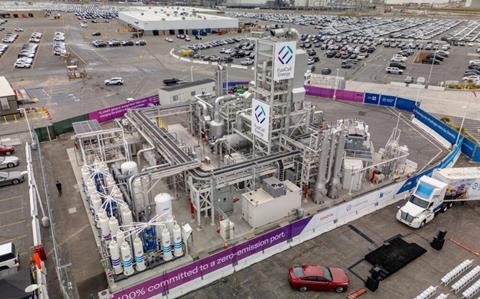Toyota Motor North America has officially opened a Tri-Gen renewable hydrogen and electricity system at its vehicle processing centre (VPC) at the US port of Long Beach. As reported in September last year, it is the first port VPC in the world to be exclusively powered by onsite-generated, 100% renewable electricity.
Working with FuelCell Energy, which makes stationary fuel cell platforms for decarbonising power and producing hydrogen, the carmaker has set up the system to generate renewable hydrogen, electricity and water from biogas to support Toyota Logistics Services (TLS) operations at the port. Toyota’s largest North American vehicle-processing facility, receives approximately 200,000 new Toyota and Lexus vehicles annually.

The Tri-Gen system can generate up to 1,200kg of hydrogen a day for fuel cell electric vehicles. That means supplying hydrogen for imported vehicles, such as the Toyota Mirai, which is exclusively imported through Long Beach, and for supplying hydrogen to the truck refuelling station at the TLS port facility. The hydrogen generation also produces up to 5,300 litres (1,400 gallons) of usable water as a byproduct. That is being repurposed for Toyota’s car wash operations, helping to reduce the demand on local water supplies by approximately half a million gallons per year.
In addition, the combustion-free process is a first of its kind nationally, reducing more than 9,000 tons of carbon dioxide emissions and avoiding six tons of nitrogen oxide emissions.
“The goal of our collaboration with FuelCell Energy was to find sustainable solutions for the TLS vehicle processing facility here at the port of Long Beach as part of our goal to remove carbon dioxide emissions from our operations,” said Toyota’s group vice-president of sustainability and regulatory affairs, Tom Stricker. “This groundbreaking facility shows that there are ways to reduce our emissions and burden on natural resources with scalable technology based on hydrogen.”
Green port initiatives
The port of Long Beach is pursuing other environmental sustainability initiatives. Together with the neighbouring port of Los Angeles, it is working on its Clean Air Action Plan, “a sweeping, innovative and comprehensive strategy to tackle every source of port-related air pollution”, according to a spokesperson for the port. “The CAAP was last updated in 2017 and now has goals of a zero-emissions cargo handling equipment fleet by 2030 and all zero emissions drayage trucks by 2035.”
Additionally, all of the ports ro-ro terminals are preparing to comply with the California Air Resources Board (CARB) At Berth Regulation. Under the rule, emissions must be captured while ro-ro vessels are at berth starting January 1, 2025.
Read more about developments at the North American vehicle handling ports in the summer edition of Automotive Logistics magazine, which is published this month.

























![Global[1]](https://d3n5uof8vony13.cloudfront.net/Pictures/web/a/d/s/global1_726550.svgz)














No comments yet